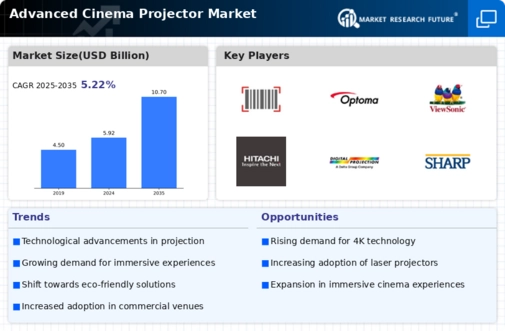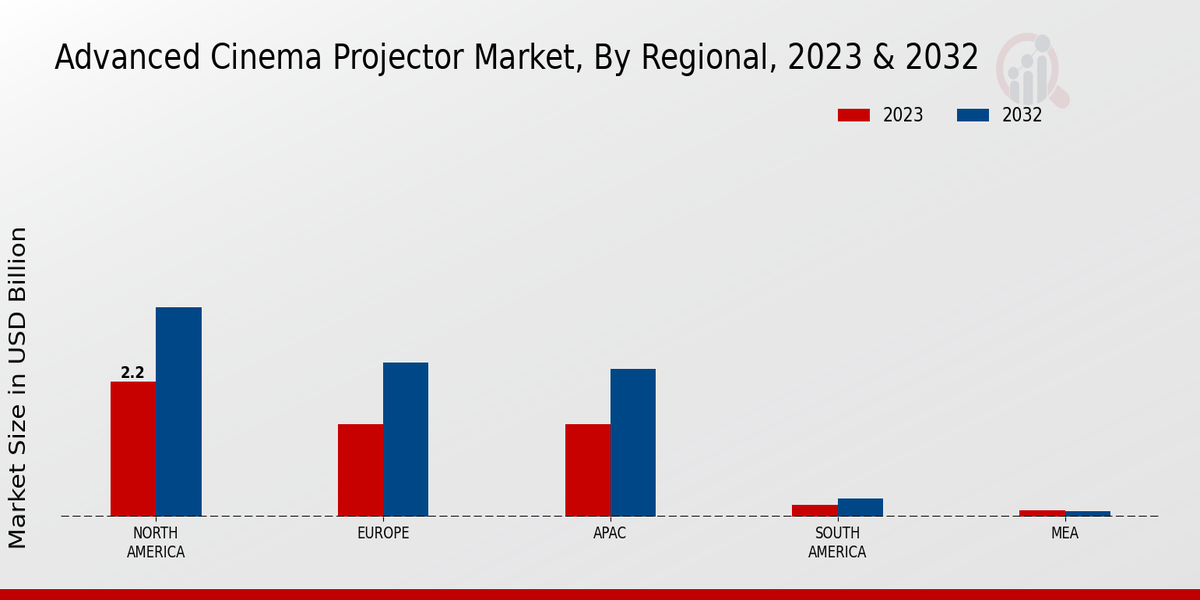Technological Advancements
The Global Advanced Cinema Projector Market Industry is experiencing rapid technological advancements that enhance the viewing experience. Innovations such as laser projection technology and high dynamic range (HDR) capabilities are becoming increasingly prevalent. These advancements not only improve image quality but also reduce maintenance costs, making them attractive to cinema operators. For instance, laser projectors offer longer lifespans and lower energy consumption compared to traditional lamp-based projectors. As a result, the market is projected to reach 5.92 USD Billion in 2024, driven by the demand for superior visual experiences in theaters.
Market Trends and Projections
The Global Advanced Cinema Projector Market Industry is characterized by several key trends and projections that shape its future. The market is anticipated to grow from a valuation of 5.92 USD Billion in 2024 to 10.7 USD Billion by 2035, reflecting a robust growth trajectory. The compound annual growth rate (CAGR) of 5.51% from 2025 to 2035 indicates a sustained demand for advanced projection technologies. Factors such as technological advancements, consumer preferences for premium experiences, and the expansion of cinema infrastructure are pivotal in driving this growth. These trends suggest a dynamic and evolving market landscape.
Expansion of Cinema Infrastructure
The expansion of cinema infrastructure, particularly in emerging markets, is a crucial driver for the Global Advanced Cinema Projector Market Industry. Countries in Asia-Pacific and Latin America are witnessing a surge in new cinema openings, which creates a demand for advanced projection systems. Governments and private investors are increasingly funding cinema projects to cater to the growing middle class and their appetite for entertainment. This expansion is likely to contribute to a compound annual growth rate (CAGR) of 5.51% from 2025 to 2035, indicating a robust growth trajectory for the market as new theaters adopt advanced technologies.
Increased Adoption of Home Theater Systems
The rise in the adoption of home theater systems is influencing the Global Advanced Cinema Projector Market Industry. As consumers seek to replicate the cinematic experience at home, the demand for high-quality projectors is on the rise. This trend is particularly pronounced in regions with high disposable incomes, where consumers are willing to invest in advanced projection technologies. The proliferation of streaming services and high-definition content further fuels this demand, as consumers desire superior viewing experiences. Consequently, the market is poised for growth as more households integrate advanced projectors into their entertainment systems.
Focus on Sustainability and Energy Efficiency
The Global Advanced Cinema Projector Market Industry is increasingly focusing on sustainability and energy efficiency. As environmental concerns gain prominence, cinema operators are seeking projectors that consume less energy and have a lower carbon footprint. Technologies such as laser projection not only offer superior image quality but also align with sustainability goals due to their reduced energy consumption. This shift towards eco-friendly solutions is likely to drive market growth, as operators aim to meet regulatory standards and consumer expectations for sustainable practices. The emphasis on sustainability may further enhance the appeal of advanced projectors in the cinema industry.
Growing Demand for Premium Cinematic Experiences
There is a notable increase in consumer demand for premium cinematic experiences, which significantly influences the Global Advanced Cinema Projector Market Industry. Audiences are increasingly seeking high-quality visuals and immersive sound, prompting theaters to upgrade their projection systems. This trend is reflected in the growing number of luxury cinema chains that prioritize advanced projection technologies. As theaters invest in high-end projectors to meet consumer expectations, the market is expected to grow, with projections indicating a value of 10.7 USD Billion by 2035, highlighting the long-term potential of this sector.















